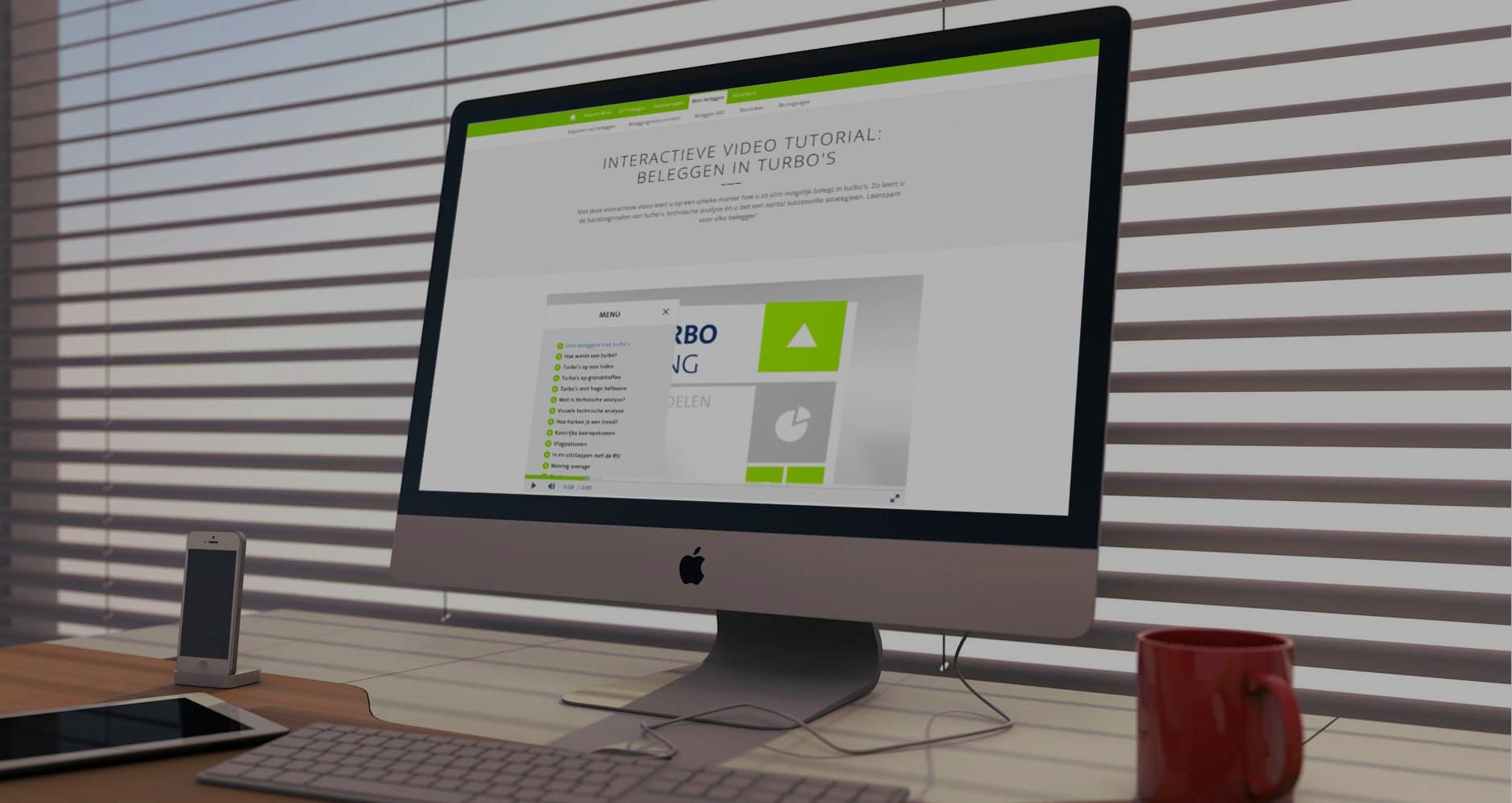How to make interactive videos? Six steps to help you get started..

People now prefer live streaming videos over other mediums when consuming content. Want to connect with your audience and engage with them in ways that drive revenue for your business? A live video is just the thing to grab and hold their attention.
Which begs the question: How do you pick the right live streaming platform for your business?
With that said, my bet is you want something that:
But with so many choices and features to consider, it may take you hours (or even days) comparing and analyzing various options before making an informed decision. And it’s time you may not have.
But don’t worry, we did all the research for you. In this blog post, we break down the top live streaming platforms that deserve your consideration this 2022!
But first, a refresher.
A live streaming platform is a solution that allows you to upload and broadcast video content to an audience in real-time.
The operative word there is “live.” A live streaming platform’s main function is not to record videos and then upload them for later viewing (although modern live streaming platforms offer features that allow you to do that in the form of on-demand video assets).
A live streaming platform can help you stream content such as:
Any business that wants to generate leads, sales, and repeat business will do well to deliver live streaming videos to their target audience. And you need a live streaming service or video streaming platform to do that.
You’re probably thinking: Why can’t I just stream my videos on social media platforms like Youtube or Instagram?
Of course you can! But before you use a free live streaming platform, it’s important to know at least what you’re signing up for.
To help you arrive at an informed decision, let’s go over the pros and cons of using a free live video streaming services.
Here are good reasons to choose a professional live streaming platform over a free one:
Finding the right mix of live streaming features is key to choosing the live streaming platform that will move the needle for your business. Here’s a nice breakdown of features you need to consider when doing a live streaming platform comparison:
The quality of your live streams has a significant impact on the experience of your viewers, and by extension, your revenue.
Does the platform use a global CDN, robust live encoding & delivery and high-quality streaming flavors? Is it using the latest live encoding codecs?
How do people get access to the stream? Is the stream publicly available, or do people need to log in with a password, unique link, or unique code? The live platform has to support these options.
Does the platform allow you to customize both the platform and the player so that the viewing experience matches your corporate brand identity? Does it let you embed your brand logo as a watermark to protect your video content and help you stay on brand? A good professional live streaming platform also gives you the option to integrate your brand colors, graphical layouts, and upload background images. It’s important that the platform is completely white label so every video experience you deliver stays on brand.
Which interactive elements does it support? You want one that lets you add clickable CTAs to get your viewers to take your desired action, whether it’s to download a PDF, sign up for an event, or go to an additional page such as the biography from the speakers of your event.

Find out what level of engagement is offered by the platform. Does it support live chat or polls? Does it allow admins to have some kind of chat moderation feature to filter incoming messages?
How do you earn money from your live streams? Is it easy? Can you sell tickets for your event? Does the live platform integrate with payment and/or ticketing providers? Can you later make the videos available as on-demand streaming with an SVOD (subscription) or TVOD (pay-per-view) model (think HBO Max or Pluto TV)?
Does the live platform offer an automated workflow that eases the transition from publishing a live stream to recording it and then making it available as an on-demand download?
At the end of the day, your videos need to deliver ROI. Whether your goal is to generate leads, retain customers, or measure engagement, you need in-depth video analytics to help you track key KPIs and generate the insights you need to steer your video marketing efforts in the right direction.
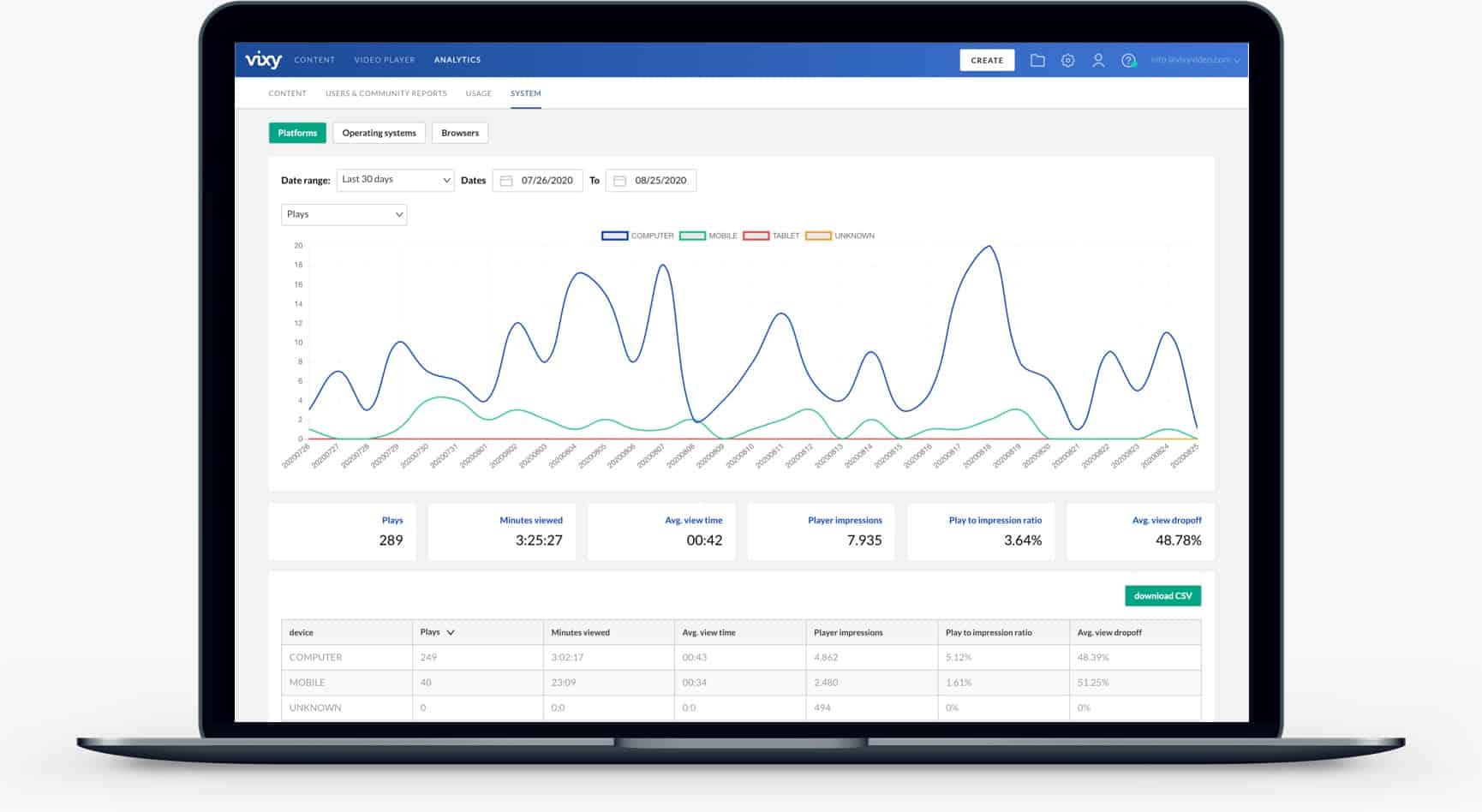
Let’s get to the fun stuff.
You now have a general idea (at the least) on which features will matter to your video marketing campaign. That knowledge will help you make an informed decision on which live streaming platform will fit your business needs and budget.
Here are the top live video streaming platforms you should look into.
Founded in 2010, VIXY Video is a video software company based in Hilversum, and is part of NEP the Netherlands. Since its launch, VIXY continues to deliver millions of streams to more than 150 countries each month, serving companies such as Basic-Fit, ING, Goodlife, Philips, Shimano, Royal Convertgebouw Orchestra, NCOI, Ekhartyoga, and many others.
If you need a one-stop solution for live broadcasting your events, VIXY livestream platform is a solution you can rely on. Both the player and page are fully whitelabel and can be branded, they use a global CDN for delivery, secure streaming with unique tokens and integrate with ticketing companies and include interactive options such as live chat, polls and questions.
VIXY Video’s most distinguishing features are its versatility and live streaming quality. Which is a big deal.
VIXY Video is secure, keeps you on-brand, and has key features that help you create a new level of engagement. Better yet, VIXY makes it easy for you to monetize your engaged users.
VIXY Video has 3 pricing plans to stream video:
VIXY’s live streaming service is an add-on which is available for €250,- Monthly, that enables you to host unlimited live streams.
See VIXY’s pricing page for full pricing details.
Since its 2010 launch, DaCast has positioned itself as a high-quality streaming solution that offers competitive pricing. In early 2019, the company strengthened its position in the OTT industry when it acquired ‘vzaar’, a video hosting platform for businesses. The company serves more than 300,0000 professional broadcasters and businesses worldwide.
DaCast is an end-to-end live streaming solution that provides secure video hosting. The video platform’s strengths lie in its user-friendliness, flexibility, and high-quality streaming. DaCast is also a great platform for beginners as it eliminates friction in setting up a live stream. You can literally start a new live stream in minutes!
The pricing plans for DaCast come in 4 levels.
As expected, the higher the cost, the more features you get, with bandwidth and storage size being the distinguishing feature between the 4 levels. If you have high-volume needs, you’ll have to contact the company so they can set you up with a custom plan that can meet your needs.
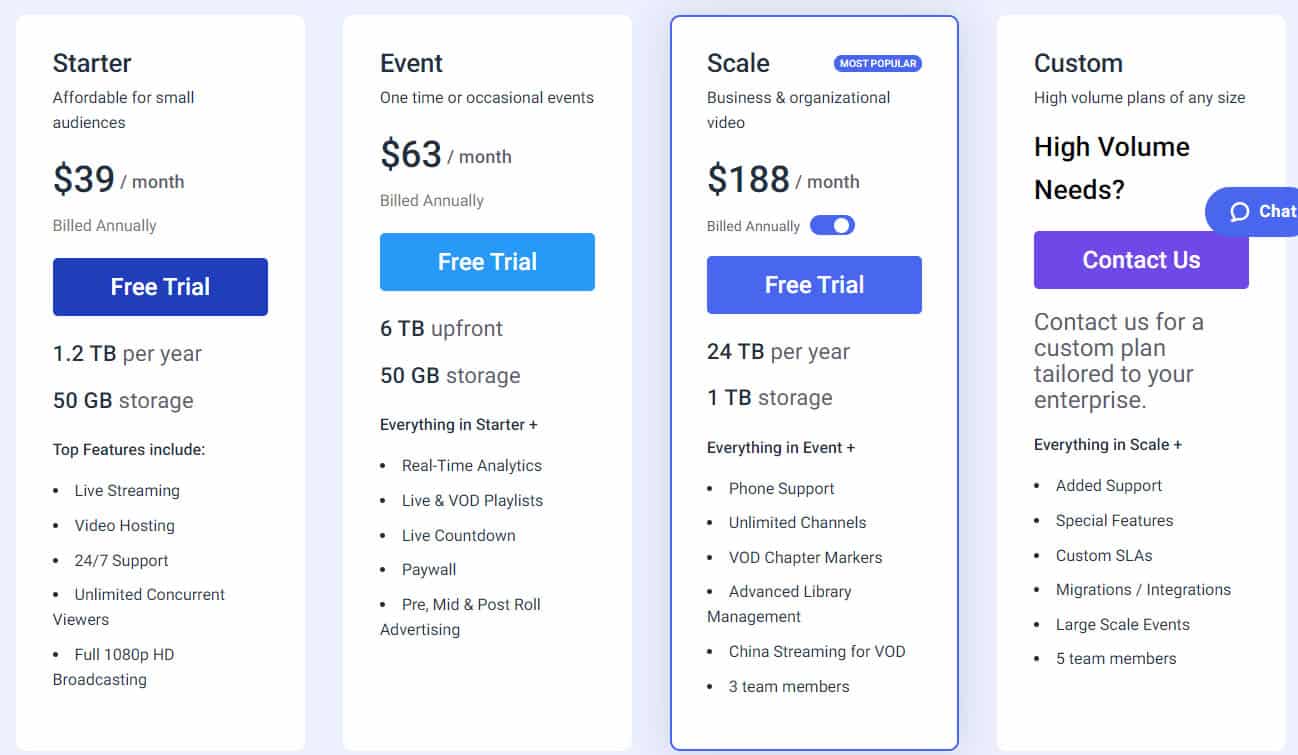
Vimeo originally launched as livestream.com in 2004 to make it easy for creative professionals to showcase their work through videos. Vimeo was the first video company to support HD video. The company later acquired VHX, Livestream, and Magisto, and launched a host of new products to help creative professionals create more engagement with live streaming content.
Vimeo makes it easy for any video content producer to create, manage, and share high-quality videos. The platform built a reputation as “Youtube for serious video producers.” But that’s an unfair comparison considering that Vimeo is fully white label, not to mention its robust OTT platform.
Vimeo has three pricing plans.
Vimeo charges $75 per month for the Premium plan, which includes both live streaming and VOD support.
The Enterprise plan includes dedicated support, advanced security and control for virtual events, corporate communications, and training. For custom pricing information, you have to contact Vimeo.
Vimeo OTT lets you launch a subscription channel and monetize your content with any app. Starting price is $1 per subscriber per month. For more details, go to this Vimeo OTT pricing breakdown.
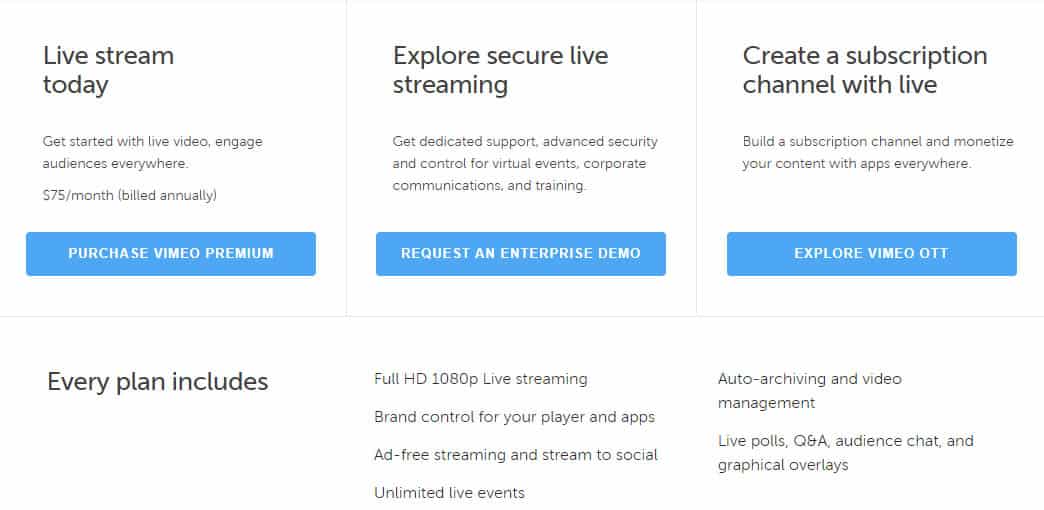
Being launched in 2004, Brightcove is one of the first video platforms to enter the scene. In fact, the Boston-based company hit its stride just when most consumers are turning to mobile devices to watch online videos. Even better, Brightcove helped companies from around the world take their live streaming to the next level, scaling their businesses efficiently as new technologies and new customer expectations emerge through the years
Brightcove excels at delivering the flexibility that businesses and content creators need to create unique and flawless viewing experiences, while allowing them to scale effortlessly as they adapt to their organization’s changing needs. The platform’s Video Cloud studio is a video producer’s dream, making it easy for organizations to set up, manage, and monetize live video events.
You need to contact Brightcove for pricing details. The company does offer several pricing plans, which include:
Muvi is an Albany-based company registered in the state of Delaware. The company is guided by a singular vision: to disrupt the OTT video and audio streaming market by offering cost-effective solutions for businesses, content owners, and producers.
Muvi is an end-to-end OTT platform that offers VoD and live streaming solutions. The platform comes with tools and features that allow brands and creators to launch their own OTT channel and monetize it easily. And all of it can be managed using a single CMS. No coding knowledge is required. The platform is also known for making it easy for producers to launch multi-screen white label videos without external support.
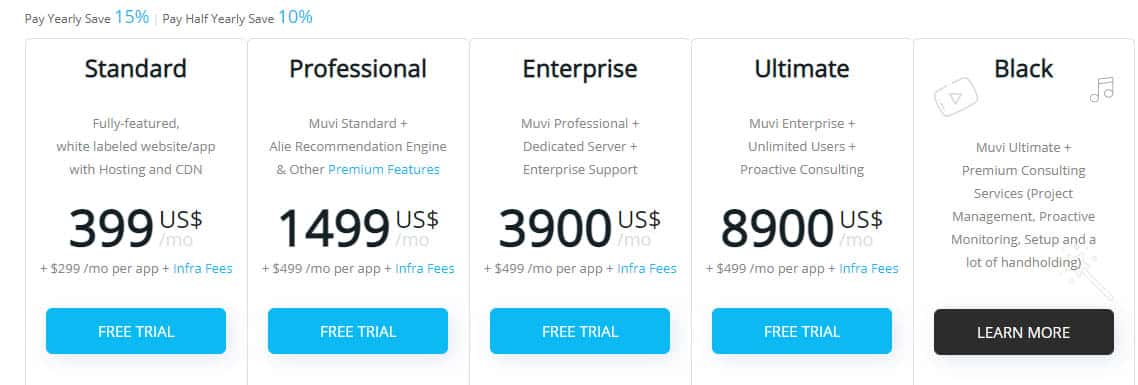
IBM Cloud Video (formerly Ustream) was founded in 2007 as a solution to help soldiers stationed in Iraq communicate with their loved ones at home. IBM acquired Ustream in 2016, making it part of the IBM Cloud Video business unit. The company now has more than 180 employees in its San Francisco, Los Angeles, and Budapest offices.
IBM Cloud Video is an all-inclusive platform providing businesses with scalable cloud-based video solutions. The platform offers reliable live streaming and video on demand (VOD) solutions while giving users the flexibility needed to host and manage complex broadcasting setups. You can watch as well as search for any video content online using this tool.
IBM pricing plans come in 4 different packages:
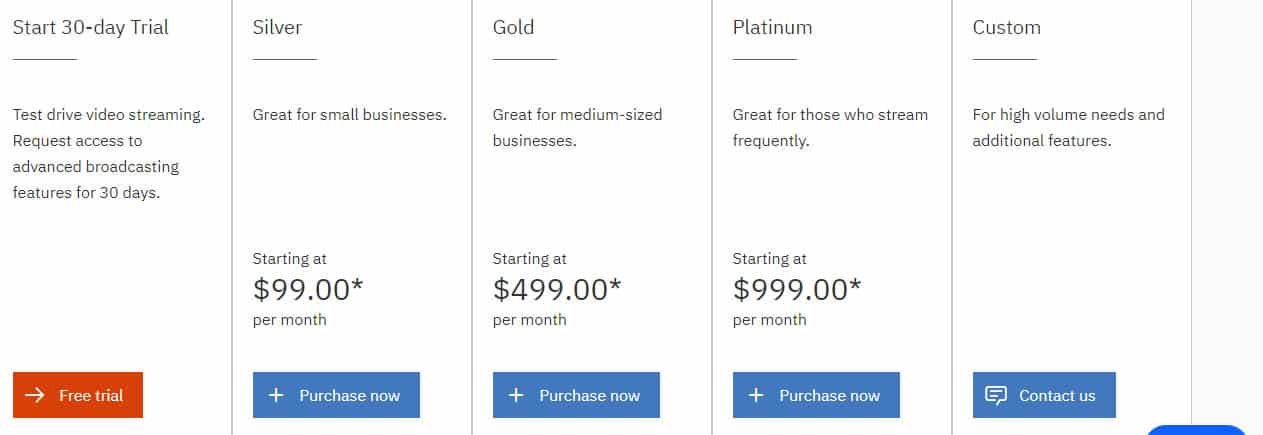
JW Player started out in 2005 as an open-source project. In fact, it became one of the leading open-source video players for Flash. In December 2015, the company dropped its open-source license. Since then JW Player has pioneered many key innovations in the video streaming industry, including HTML5, Chromecast, and more.
JW Player offers a comprehensive video platform that allows every type of business to connect with its audiences and boost its revenue. The platform’s best feature is its HTML5 video player, making it easy for businesses to integrate videos into their website without relying on code. Streaming quality is top-notch thanks to its adaptive streaming technology.
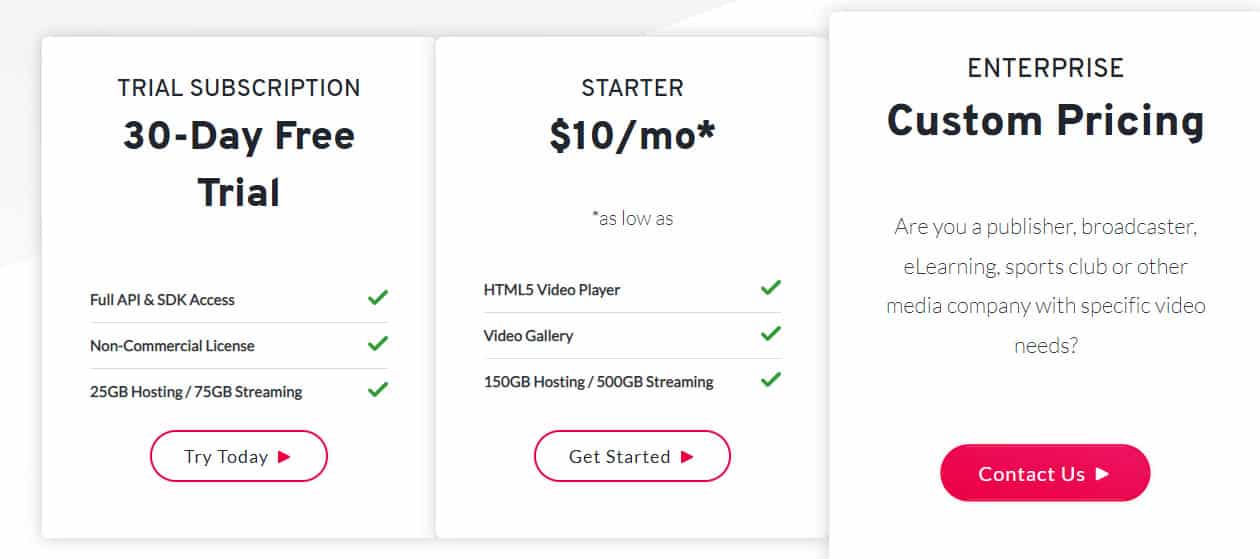
With more than 2 billion monthly users, it’s safe to say that Youtube is the most popular entry in this list. Nearly two years following its founding in 2005, Google acquired Youtube, turning the platform into the undisputed leader in online video. As of May 2019, more than 500 hours of video content are uploaded on Youtube every minute.
Youtube Live is a free service that allows you to broadcast videos to people around the world in real-time. It’s also easy to get up and running. Since Youtube Live is a free service, Youtube has partial rights to your content.
Facebook, like Youtube, doesn’t need an introduction. That said, its live platform Facebook Live is not without its humble beginnings. Launched in August 2015, Live was made available to celebrities only, starting with Dwayne “The Rock” Johnson. The platform increased in popularity through the years. In 2016, Facebook Live became available to non-celebrities as well, and the live streaming platform has started blowing up since then.
Facebook Live allows Facebook users to broadcast live videos to their audience. While the livestream is ongoing, the audience can engage with the video via reactions and comments. People who engage with your videos can also receive notifications from the live stream.
So there you have it – the best live streaming platforms that deserve your attention. Now it’s time for you to make a choice.
Final piece of advice? Choose the live streaming platform that will benefit your audience the most. While there is no perfect live streaming platform, you can choose one that’s perfect for your audience’s needs.
With that said, if you want to keep serving your audience, you need to do what’s necessary to make your business thrive. How to pull that off? Give your customers a branded experience and monetize their engagement.
Want to give your audience a live streaming experience that will keep them coming back? Book a demo with us and we’ll be happy to show you how!

